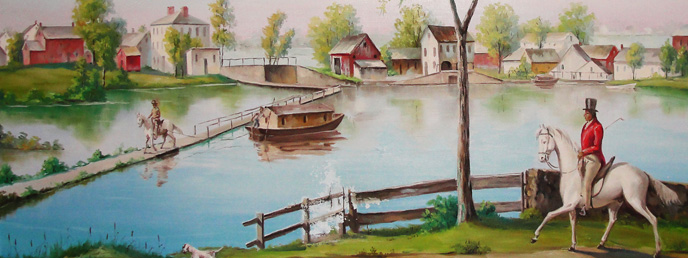


Middlesex Canal Association P.O. Box 333 Billerica, Massachusetts 01821
www.middlesexcanal.org
| Volume 58 No. 2 | February 2020 |
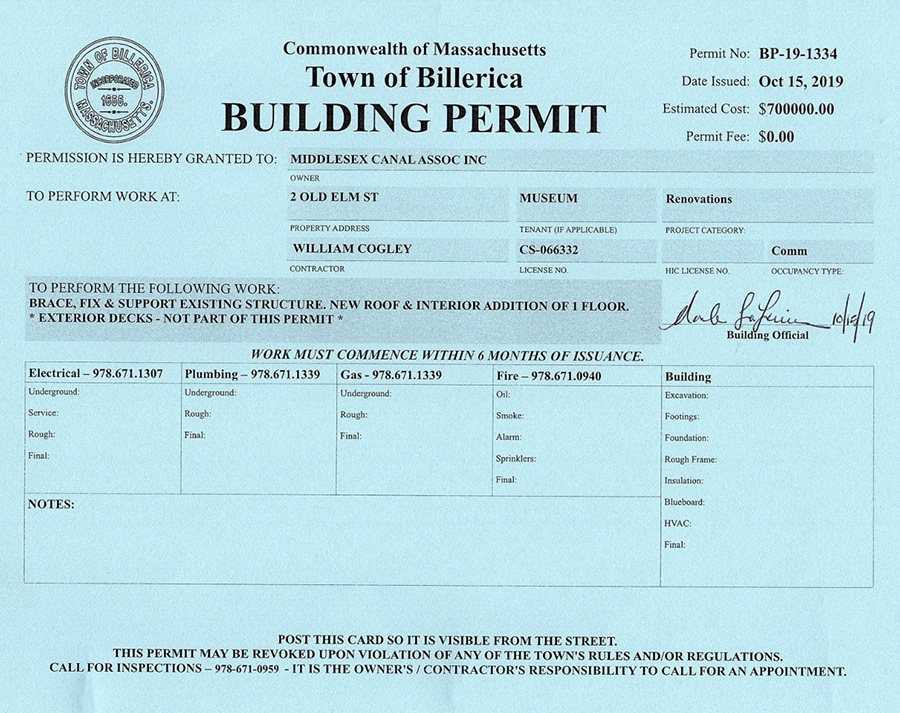
Finally, a light at the end of the tunnel! Thank you to all who helped in obtaining this permit, with a special applause to J Breen and Betty Bigwood.
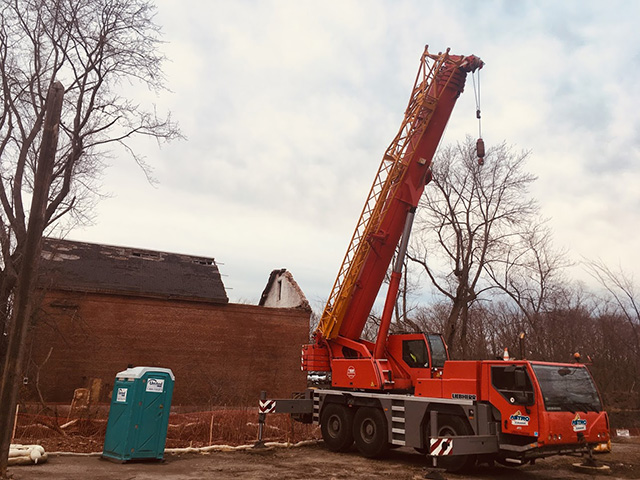
The first visible signs of progress at the proposed MCA Museum site. Pictured, on January 7, 2020, is the
million-dollar crane. When the boom is extended it reaches over the remnants of the canal, enabling the
removal of the roof. Photo Courtesy of Marlies Henderson

¾ of the Roof has been removed as of January 9, 2020. Courtesy Betty M. Bigwood
Please mark your calendars
MCA Sponsored Events
2020 Schedule
Winter Meeting, 1:00 P.M. Sunday, February 9, 2020
Speaker: Alison Field-Juma
Executive Director of OARS: for the Assabet, Sudbury and Concord Rivers
Spring Walk, 1:30 P.M., Sunday, March 22, 2020
Billerica South to Small Pox Cemetery
Bike Tour South, 10:44 A.M., Sunday, April 19, 2020
Spring Meeting, 1:00 P.M., Sunday, May 3, 2020
Speaker: TBA
18th Bike Tour, North, 9:00 A.M. Saturday, October 3, 2020
Fall Walk, 1:30 P.M., Sunday, October 18, 2020
Wilmington Town Park to Patch’s Pond
Fall Meeting, 1:00 P.M., Sunday, October 25, 2020
Speaker TBA
The Visitor/Center Museum is open Saturday and Sunday, noon – 4pm, except on holidays. The Board of Directors meets the 1st Wednesday of each month, 3:30-5:30pm, except July and August.
Visit www.middlesexcanal.org for up-to-date listings of MCA events and other events of interest to canallers!
TABLE OF CONTENTS
MCA Sponsored Events and Directions to Museum
President’s Message by J. Jeremiah Breen
How is Two Old Elm Coming Along? by Betty M. Bigwood
Our Contractor: Bill Cogley - A Man for All Seasons by Betty M. Bigwood
The Middlesex Canal Association Fall Meeting - October 27, 2019 by Debra Fox
Women’s Roles on the Middlesex and Merrimack River Canals by Bill Gerber
The Visit - October 21, 2019 by Debra Fox
Part #6 and final in the Series: A Social History of the Middlesex Canal an e-book by Rev. Alan Seaburg
Dahill’s Middlesex Canal Murals
Eagle Scout Project in Wilmington, MA by Betty M. Bigwood
Editors’ Letter
January, 2020
We would like to begin this letter by highlighting the last article first. The end of the last installment of Alan Seaburg’s ebook is a short artist sketch (in words, not pictures) of Tom Dahill followed by a narrative by Tom about the three murals that he has painted for the Visitors Center. This piece should become a stand-alone brochure for visitors of the new museum. Have any of you ever toured an art exhibit while reading the artist’s words about how he/she chose what you are looking at in the picture? Maybe, but not often. Panels next to each mural might work too, without the paper/printing costs. Regardless, it is an excellent tour through Tom’s work and a priceless resource.
Yes! Work to be done on the new museum has been given a building permit and the proof is right on the cover for examination. Also, in this issue are reports from the Fall Meeting, visitors with a historic connection, speculation about a neglected piece of canal history by Bill Gerber, and as mentioned earlier, the last installment of Alan Seaburg’s book.
Check out the list of activities that may help shake off the short, dreary winter days. As always, comments, criticisms and/or suggestions are appreciated by all the editors.
Enjoy! Deb Fox, Alec Ingraham, Robert Winters
MCA Sponsored Events and Directions to Museum
Winter Meeting: The winter meeting of the Middlesex Canal Association will be held on February 9, 2020 at 1:00 P.M. at the Middlesex Canal Museum and Visitors’ Center at 71 Faulkner Street in North Billerica, MA 01862. The public is invited and welcome to attend the meeting.
Alison Field-Juma will present the first-ever River Report Card for the Sudbury, Assabet and Concord Rivers at the next Middlesex Canal Association meeting on February 9, 2020. She is the Executive Director of OARS, the watershed organization for SuAsCO (www.oars3rivers.org) which monitors water quality and works to improve the health of the three-river system.
The Middlesex Canal lies near the border of the Upper Concord River which received a B and the Lower Concord River which received a C+. Come find out why, and enjoy a lively dialogue about what matters to our communities and what we can do about it!
See the Report Card at ecoreportcard.org.
Spring Walk: On Sunday, March 22, 2020 the AMC and the MCA will sponsor a canal walk. The walk will be for 2 – 3 hours, rain or shine, over generally level wooded terrain and streets. The route follows the canal for a round trip of under three miles south of the Concord River. Sites to be visited include: two guard locks; an anchor stone; the causeway at opposite ends of the floating towpath across the summit pond; the 1825 iron bolt pond-level reference; the “deep cut”; a small pox cemetery; and the photovoltaic facility on High Street. Leader will be Robert Winters (617-661-9230; robert@middlesexcanal.org). Meet at 1:30 P.M. at the Middlesex Canal Visitor Center/Museum at the Billerica Falls of the Concord River, 71 Faulkner Street, North Billerica, MA 01862, 3 blocks west of the North Billerica train station. The Visitor Center opens at noon.
Bike Tour South: On Sunday April 19, 2020, the Middlesex Canal Association will lead a bicycle tour of the Middlesex Canal. Incorporated in 1793 with John Hancock as the first proprietor, the canal connected the Merrimack River at Lowell with the Charles River at Boston by a ditch 3½ feet deep, 30 feet wide and 27 miles long. It was the greatest work of its kind in the United States until the Erie Canal. The canal operated for 50 years, then the one-horse power canal boat quickly lost to the new competitor, the 30 horse-power steam locomotive.
The tour will start at the train station in Lowell after the 10:44 A.M., when the 10:00 A.M. train arrives from Boston. This year an early group will take the 8:00 A.M. train from North Station to allow more time in Lowell and breakfast at the Owl Diner, United States Historic Landmark, www.owldiner.com. Train fare is $10.00. The tour visits Lowell canals, River Walk, Francis Gate, the canal plaque at Hadley Field, then south on the route of the Middlesex Canal. Riders will stop at the mini-mall, 95 Boston Road (Rte. 3A), Billerica, MA for lunch around 1:00 P.M. followed by a quick visit to the Middlesex Canal Visitor Center/Museum, 71 Faulkner Street, North Billerica, MA 01862 and then back to Boston.
A long day, but the sunset is late. Cyclists wanting a shorter tour can plan their own start and stop points using the Lowell line schedule available at mbta.com. Anderson/Woburn station off 128/I-95 and I-93 is popular. Another possible start/stop point is North Billerica because the Visitor Center is two blocks from the station and is open noon – 4:00 P.M.
The route is pretty flat – the summit pond was 27 feet above the Merrimack – and we will average 5 miles per hour, so the ride will be an easy one for most cyclists. The ride will be led by Bill Kuttner, bkuttner@ctps.org, 617-241-9383, and Dick Bauer, dick.bauer@alum.mit.edu. 857-540-6293. Helmets are required. Steady rain cancels. The map for the bike tour south is in two parts, tinyurl.com/lowellsouth and tinyurl.com/wedgemere.
Directions to Museum: 71 Faulkner Street in North Billerica MA.
By Car
From Rte. 128/95
Take Route 3 toward Nashua, to Exit 28 “Treble Cove Road, North Billerica, Carlisle”. At the end of the ramp, turn left onto Treble Cove Road toward North Billerica. At about ¾ mile, bear left at the fork. After another ¼ mile, at the traffic light, cross straight over Route 3A (Boston Road). Go about ¼ mile to a 3-way fork; take the middle road (Talbot Avenue) which will put St. Andrew’s Church on your left. Go ¼ mile to a stop sign and bear right onto Old Elm Street. Go about ¼ mile to the bridge over the Concord River, where Old Elm Street becomes Faulkner Street; the Museum is on your left and you can park across the street on your right, just beyond bridge. Watch out crossing the street!
From I-495
Take Exit 37, North Billerica, then south roughly 2 plus miles to the stop sign at Mt. Pleasant Street, turn right, then bear right at the Y, go 700’ and turn left into the parking lot. The Museum is across the street (Faulkner Street).
By Train
The Lowell Commuter line runs between Lowell and Boston’s North Station. From the station side of the tracks at North Billerica, the Museum is a 3-minute walk down Station Street and Faulkner Street on the right side.
President’s Message - “Visitor Center Deck”
by J. Breen
This past year, 2019, the Middlesex Canal Association Visitor Center/Museum, 71 Faulkner St., was a school for more than 300 3rd graders over seven days to have a history lesson about the canal of John Hancock and his compatriots. The lesson is funded by a $10,000 grant received in 2008 from the J. M. R. Barker Foundation and the contributions of the teachers, parents, and volunteers who participate.
The Association asked the Billerica Conservation Commission for permission to build a deck on the river side of the new visitor center, offering an excellent point on the Concord River bank to observe the dam, summit pond, the canal entrance north to the Merrimack River, and the west and east termini of the floating towpath, mooring rings and causeway, respectively. Third graders will have a memorable learning experience.
Billerica has a 25’ no-build zone on riverfront property, thus the need for permission beyond usual environmental review and requirements. (Two Old Elm has a “grandfather” exemption under state regulations, 310 CMR 10.58(6) (k) Activities within an Historic Mill Complex, but not under Billerica regulations.) The Association submitted an 89-page Notice of Intent prepared by a professional environmentalist at a cost of something like $25,000 to the Commission on Sept. 12, 2018. The first comment from a commissioner was the suggestion of a wild flower garden for pollinators instead of a deck with shade loving plants under it. Later comments, a picture window, a patio, geese will poop on the deck, litter will fall into the river. After nine months and $15,000 more in professional fees, the Commission published a 29-page order recorded in the Middlesex North Registry, book 33074/page 159, permitting the adaptive reuse of the 150-year-old wool cloth storehouse as a visitor center/museum with a deck.
Both the Zoning Board of Appeals granted a variance and special permit and the Board of Health approval in their single public hearing. Subsequent to one meeting before the Community Preservation Committee, Town Meeting granted $100,000 to the Association for the Two Old Elm St. project. The Wild and Scenic River Stewardship Council, the official advisory committee to the National Park Service for the Sudbury, Assabet and Concord Rivers, recently emailed the Association as follows:
Great news! The River Stewardship Council has accepted your proposal to help fund an observation deck on the Concord River. My apologies for the long delay in getting back to you.
The Council is glad for your efforts to provide an exceptional view of the Concord River, with all of its aesthetic, historical, and ecological values. We are pleased to fund your proposal for $10,000. Thank you for bearing with us through our decision process.
The grant agreement (which I’ll send you shortly) will state, per our discussions by phone, our understanding that the deck is planned to be on land next to the building, and will not affect what may happen down the line with the dam and fish restoration. We want to make it clear that supporting the deck and the Museum is not a statement from the Council with regard to any particular solution related to the dam. Additionally, the funding is contingent on your commitment to work with us on some type of mutually agreeable interpretation on the deck. We’ve set aside an additional $1,500 for a panel or sign at that site. This makes our total grant funding to you $11,500!
We look forward to supporting your efforts to build an excellent experience on the Concord River.
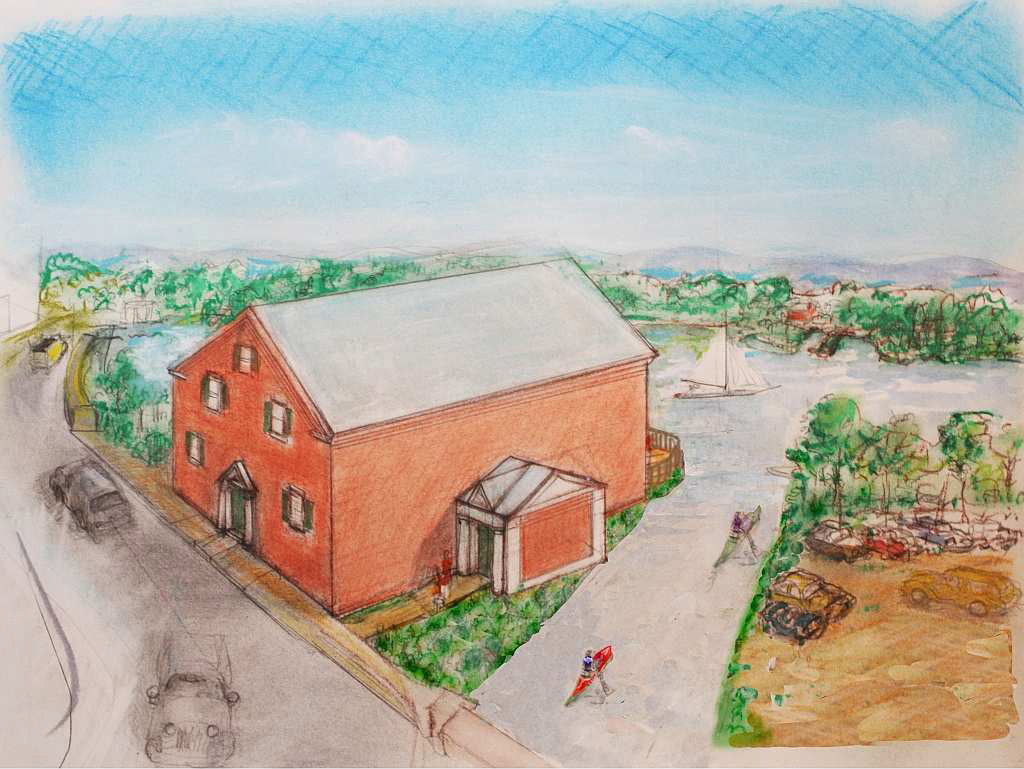
Future Middlesex Canal Visitor Center/Museum, 2 Old Elm St, Billerica, MA 01862
A Note of Appreciation
To date over $9000 has been donated to the Annual Appeal including $1000 to the Endowment Fund and almost $5000 to the Building Fund.
It might have been expected that this most recent appeal would show a lower total because, in recent months, some of our members who are often among the largest contributors have given significant amounts toward the 2 Old Elm Museum Building renovation project. However, many others have increased their donations and as a result the total from the Annual Appeal is similar to recent years.
The treasurer would like to thank the fifty contributors to the Annual Appeal. So I will. Thank you, fifty contributors.
Russ Silva, Treasurer
How is Two Old Elm Coming Along?
by Betty M. Bigwood
We have divided this project into phases: the first is to get a WEATHER TIGHT BUILDING. This involves gutting the building, removing the roof, putting up the steel columns and beams (an inside skeleton), putting on a new roof and installing windows.
When Tom Raphael worked with Bill Donovan of Pace Industries to transfer the property at 2 Old Elm to the MCA in 2014, we never in our wildest dreams expected the permitting process to take so long or be so complicated. Our tenth of an acre site, surrounded by water on three sides, raised numerous concerns by the Billerica Conservation Commission which had to be addressed. Getting their approval – the Order of Conditions - on 6/11/19 was a milestone. A negative lead paint and asbestos survey was a welcome relief. Lead at the site would have added thousands of dollars to the disposal budget. Billerica’s Building Commissioner Mark LaLumiere issued us a Building Permit on 10/15/19.
Fortunately, we have received three grants/rewards: (1) $100,000 from the Billerica Community Preservation Commission. “More than twenty years after the Community Preservation Act became law, more than half of the 351 cities and towns in Massachusetts participate in this self-determined investment plan for open space, historic reservation and affordable housing” (Globe) and Billerica has joined. (2) The Town of Billerica waved the $7000. Building Permit fee and (3) the Sudbury, Assabet and Concord Wild and Scenic River Stewardship Council has donated $11,500 for construction of the observation deck and signage. We are anticipating the cost of this adventure to be $1.5 million dollars of which we now have $1 million. We have some work to do.
Unfortunately, the building had deteriorated significantly during the long permitting process and a reassessment of costs and plans had to be negotiated in August. It was touch and go. We were significantly encouraged by a well-known mason Ed Dolliver, who lives nearby and specializes in antique buildings, to continue. Structural Engineer Paul Phelan had to redesign the inside metal structure to conform to new 2014 seismic requirements. We asked Bill Cogley from Whitinsville, Massachusetts to be our contractor and a date was set to start after his Thanksgiving holiday in Florida. An unexpected event occurred – an early 5-6 inch snow storm – and we worried if anything could be done in 2019.
A week passed before we heard from Bill: “could three rows of brick be removed from around the front and only door to allow his small Bobcat with back hoe to enter the building? The door needed to be replaced.” We agreed. As they took down the brick around the door, they discovered an eight-inch space – larger than expected - between the two layers of brick making the 18-20 inch walls. Then there was silence for a week. Unbeknownst to us, Bill was working alone in the building for a week demolishing the interior. On December 23, 26 and 27 there was a lot of activity: orange cones appeared along the road to the parking lot, a single Billerica policeman was on duty and two Bobcats with front end loaders went back and forth through the opening to collect debris and put it in the dumpster. They cleared it out.
This Project is under supervision by the Billerica Conservation peer review officer, Brian Dunn, who provides cooperation between us and the Town of Billerica. He pops in frequently at $450 a time. When J asked in amazement after hearing he was going to come twice a week. “You mean you are going to charge us $1000 a week? He is coming less frequently. In addition, we have our own Conservation representative, Scott Smyers who has been put on an “as necessary basis”. We need to curb costs. Bill Cogley has his men frequently walking the site so that no debris is left around or in the water/ice which dereliction would cause more frequent visits.
We are currently in negotiation with the National Grid for relocation of the electrical pole/lines which is located too close to the building for the mason and roof installation regulations. They may allow us to move the pole across the road but no decision has been made. As J likes to say “This Is Massachusetts!”
As with any old project you discover new challenges. After the wood flooring was removed, they found a concrete floor in various levels and slopes. It has been decided to remove the concrete and level the floor with new gravel to provide a good foundation. In the south west corner of the building they discovered a 7 ft. by 10 ft. deep room which Bill and J enjoyed investigating. The top nine feet of the room is dry with standing water at the bottom. Numerous pipes and turn off values are there for an old sprinkler system. There was an outside SW entrance to this room which had not been investigated until now. Another snow storm delayed progress.
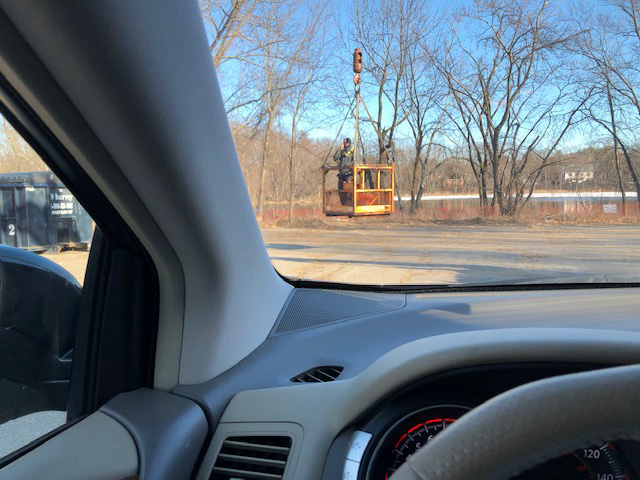
Contractor Bill Cogley in the bucket of the crane
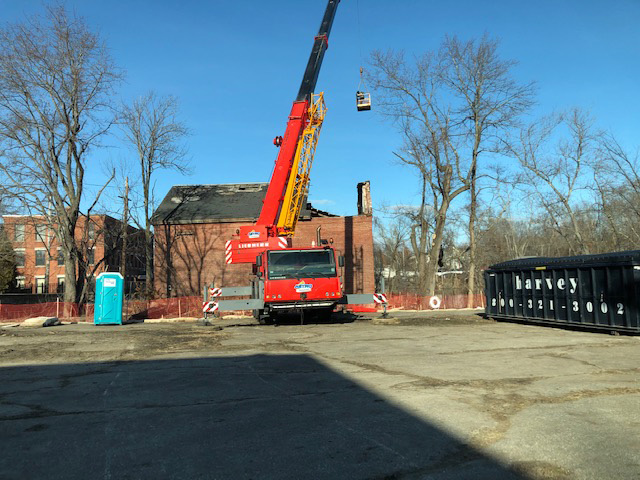
Contactor Bill Cogley dangling in the air above Two Old Elm Street
After the New Year holidays, for 4 days (January 7-10), a $3000 /day crane was hired to partially take down the roof. Ten ft. of the west side of the roof, on the street side, needed to stay to stabilize the gable end will wait until spring. Bill, dressed for very cold weather, was hoisted ~50 ft. in an open box by a chain attached to the cranes intersecting boom and placed strategically by the crane operator who was directed by hand movements and a dual walkie-talkie. Bill took J up for a bird’s eye view of the situation. Unfortunately, there is considerable mortar decay which means that additional layers of brick will need to be reset. Bill used a reciprocating saw to take down the roof and allowed it to fall below. Next week, January 13, they will once again put up the cones, hire a Billerica policeman and start the Bobcat removal of debris from the building to the dumpster.
If the weather holds, Shaw Welding will start putting in the metal skeleton. If the weather does not hold all work will wait until Spring. Mason Ed Dolliver plans to start his brick work in mid-April after which we can install a roof. Hurrah!
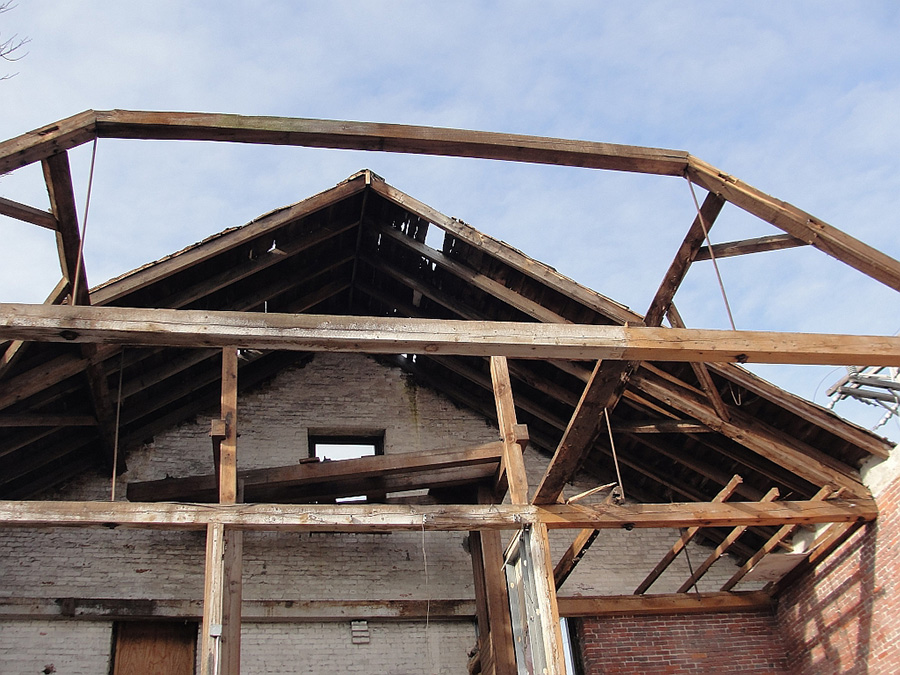
Queenrod Truss Purlin and Brace

Betty Bigwood and general contractor Bill Cogley in doorway
Howard Winkler was so pleased that we started, he sent this endearing quote from Calvin Coolidge to the Building Committee: “Nothing in the world can take the place of persistence. Talent will not: nothing is more common than unsuccessful men with talent. Genius will not; unrewarded persistence and determination alone are omnipotent.” Or as J puts it “Just show up”.
Our Contractor: Bill Cogley
A Man for All Seasons
by Betty M. Bigwood
We first met Bill Cogley in 2017 after he was highly recommended by Rick Shaw of Shaw Welding in Billerica. Over the past three years he has been a kind, helpful, and steadfast source of information. We trust him.
Bill is 52 years old and has been in the construction business since he was a teenager. When I asked Bill how he got started he replied “with a pick ax and shovel”. He went on to say that he was raised in “the projects” and foster homes. It was a tough beginning. He had worked for a contractor for nine years and one day the employer fired him: Bill was shocked. When he told Bill that he was letting him go, Bill asked why, the Contractor replied “You are too smart to work for anyone; You need to work on your own.” Then he helped Bill buy a very old second hand truck and sent him on his way. Bill never looked back.
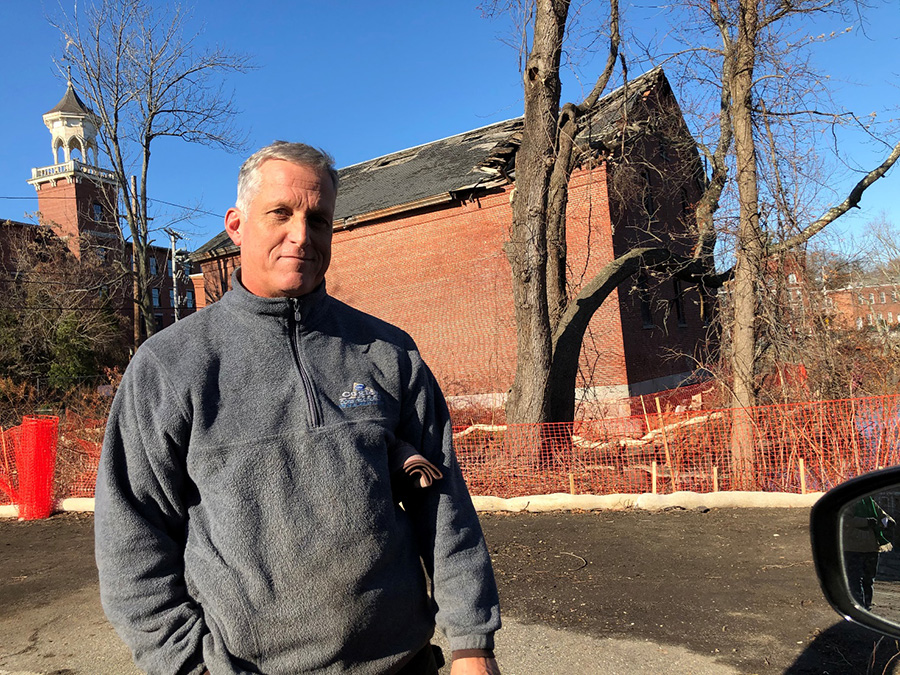
Bill Cogley at Two Old Elm Street (December, 2019)
On getting this photo my sister replied “Keep the handsome Contractor. Give the building back.”
Bill rarely took easy jobs, instead took on challenging work which required some special effort. He thrived and built up an all-consuming business with million dollar pay roles. He was 39 when he married. He learned to fly and bought land in Florida which he plans to develop and built a house there on an island where he heads in the winter, but is realistic enough to know that it will be under water in 20 years.
Bill is a “hands on” contractor preferring to do the job himself. I watched in awe as the crane lifted him up ~fifty feet over the roof of two Old Elm and the roof boards he cut collapsed into the building. He took several types of saws with him but settled on a reciprocating saw after he found that the old hand cut nails destroyed a chain saw blade in about 20 minutes.
Bill watches the costs of our project for which we are very grateful. This effort has proven to be an extraordinary adventure by all concerned. Having Bill lead this project is a bonus.
The Middlesex Canal Association Fall Meeting
October 27, 2019 @ 1:00 P.M.
by Debra Fox
The Middlesex Canal Association Fall Meeting got off to another roaring start with President J. Breen blowing the conch shell to call it to order. There was no business to discuss and none of the members present in the audience had questions or comments. With business out of the way, President Breen introduced Marlies Henderson who then introduced the guest speaker.
Robert M. Thorson, originally from Minnesota, is a professor at the University of Connecticut. His field is geology and he was drawn to the Concord, Massachusetts area to study Walden Pond and the Concord River and he has published a book on each topic. His lecture was titled “Concord River, Billerica Falls Dam, and Thoreau.”

Professor Robert Thorson October 27, 2019
Professor Thorson’s lecture traced the history of the mill pond and dam and the rivers in the early 19th century in relation to the impact of human changes to these landscapes. An important aspect of his work has been to study Thoreau’s journals of his river observation, detailed and measured over many years. This data can now be used to study impacts of human development; i.e. dams and bridges, to flooding and sand bar buildup. He calls Thoreau the “first river naturalist.” He ended his talk showing slides with beautiful images of the river throughout the seasons emphasizing how the beauty that Thoreau saw is something we can all still see.
Questions and comments followed from the large audience of over 50 people. There were representatives of anti-dam groups and fish-ladder groups but conversation was civilized and talking continued long after the meeting adjourned.
The usual display of food was prepared by Betty Bigwood. Included were ham biscuits, a cheese and cracker tray, salad, drinks, and in honor of fall, hot apple crisp and vanilla ice cream!
Women’s Roles on the Middlesex and Merrimack River Canals
by Bill Gerber
Each year the Middlesex Canal Museum hosts many dozens of third-graders from local elementary schools to introduce them to the canal and its contribution to the local area, to Boston, and to the Merrimack Valley.
During their visit, the students are guided through a series of exercises, after which they are bussed to visit a field site to see the remains of an aqueduct and a still recognizable section of the canal.
This fall, after spending time at the museum and hearing of the work of the men who built and operated the canal, one young girl asked what women did on the canal. Oh my, has no one ever asked this question before?
A proper response to the question might entail a study, assuming that one could find materials such as diaries from women of that time who actually lived and worked on or near the canal. But that would take some time and it seems unlikely to produce the intended result. Accordingly, this is not that study. To the contrary, what follows is my response to the question, based simply on impressions gained over the many years I’ve researched the topic.
Note that, unlike later and larger US canals, there are few if any indications that Middlesex Canal boatmen lived aboard their boats, or that they took their families with them (though I’m sure they did from time to time, e.g., if a farmer, then on market day to attend to customers and sales; for mom and the kids to see ‘the big city’; or to visit relatives; etc.). On the Middlesex, boatmen’s (and travelers’) needs for meals, accommodations and socialization, at least a portion thereof, appear to have been met by the ‘exoskeleton’ of lock-keepers houses and taverns that sprang up along the canal.
Most of what I’ve read about the canals lead me to believe that, in those earlier times, preference would have been given to employing men, including young men and sometimes boys, to perform ‘main stream’ tasks. Nevertheless, I expect that women and girls were probably also involved in most activities and at most, if not all, levels of those activities. More likely, though, they were involved in family related endeavors, as compared to commercial enterprises. And most of the time young women would have been accompanied by a father or brother or husband who offered a measure of ‘protection’ in the ‘rough and tumble’ environment that the canals sometimes presented.
Girls, even young girls (e.g., age 8 to 10 and up) might very well have led the tow animals (horses and mules, and perhaps the oxen) along the towpaths much the same as young boys. In similar fashion, the same might have cared for the tow animals - seeing that they were fed and ‘watered’; removing their harnesses at the end of one day and mounting them at the beginning of the next; brushing the animals down after and before each of the harnessing sessions; inspecting, cleaning and ’picking’ their hooves, and so on.
Young women (e.g., likely a bit older) might also have steered the boats, both on the canal and on the rivers. Considering that the boats were heavy and cumbersome, and with loads they were much more so, no doubt it took diligent attention and a measure of strength to steer them; also, to row or pole them when on the river. Hence my expectation is that related tasks, if at all, might have fallen on somewhat older, stronger women.
Going up the river it is conceivable that some women poled the boats upstream right along with the men; though this was hard, sustained, rhythmic work and thus more likely considered to be a man’s job, but probably not exclusively so.
Traveling on rafts was slow, and considering that a raft of timber, e.g., oak, could weigh as much as 100 to 150 tons, and that multiple rafts could be strung together in-trail, to form a ‘band’, it seems unlikely that women were called upon very often to steer the rafts, not on the river and perhaps not on the canals either. If included in such an endeavor, it seems more likely that they would be the wife of one of the crew and the cook for the expedition.
Girls and young women were unlikely to be involved.
At the lock-keeper’s houses and taverns, women, including young women, undoubtedly performed all of the traditional housekeeping tasks for their family and, if they had time available, may have served boatmen and travelers as well. No doubt they assisted in cooking and serving meals. And they might well have helped to care for the tow animals as noted earlier.
At the beginning of the day, once ‘on the water’, most boatmen were probably reluctant to stop for very long until the end of the working day. Thus it may have been that the lock-keeper’s houses and taverns would have prepared a ‘Bargee’s Pail’ or equivalent with food to sustain the boat crew along the way (hopefully a ‘hot meal’ during the colder times). If done, it seems likely that this was a task that the women of the establishment were more likely to have taken on.

Enterprising lock-keeper and tavern families might have engaged in small retail activities, preparing, stocking and selling food and/or other essential items to the boatmen and travelers who passed by. If so, likely these were small businesses primarily operated by the women of the family.
At the same locations, young women probably also set up and operated the lock(s), and assisted the boats through, about the same as the men would have done. In fact, to the extent that the lock keeper maintained a small farm or orchard, or whatever, and found it necessary to spend time in his fields, the actual day-to-day tending to the locks may have fallen more on wives and children than it did on the ‘official keeper’.
At the Landings, where goods to be shipped were taken in, warehoused for a short time and then loaded aboard a boat for transport, (or all of this in reverse for arriving/shipped goods) women, including young women of the Landing agent’s family, may have conducted or assisted with all or most related tasks. Where the Landing facility provided means and materials to butcher cattle or other farm animals and pack meat for market, likely women, perhaps young women, would have been involved in many, if not all, of the related tasks.
And in all of the foregoing, women, more likely wives and older women, probably looked after the business side of these endeavors about the same as the men.
Bottom Line: though I don’t find them mentioned in the historical documentation, or in the reports of other researchers, my guess is that women were involved on the canal in just about every capacity, from the time that they were old enough to perform the tasks at hand. And they would have continued on until, for whatever reason, they were no longer able to do so.
So now, who was the third-grader who asked the question? What would she have to say about the foregoing suppositions?
The Visit - October 21, 2019
by Debra Fox
The Middlesex Canal and Visitors’ Center was the scene of a reception for three Faulkner family descendants, hoisted by the new Board of Directors of the Faulkner Kindergarten. Having driven through the night from Kentucky, descendants Jesse Preston Brandt, and grown children, Alice Nauman and Dan Brandt were spending barely twenty-four hours in Massachusetts.
Alice, from Kentucky, will be helping administer the Faulkner Kindergarten Trust. She had never seen the kindergarten nor met the director, Deb McEachern. Her mother, Jesse Preston Brandt had been to the kindergarten, a former family home, many times with her father on their way to their summer home in Maine. It was her wish to see the Faulkner piano at the Museum that initiated the reception in the Reardon Room.
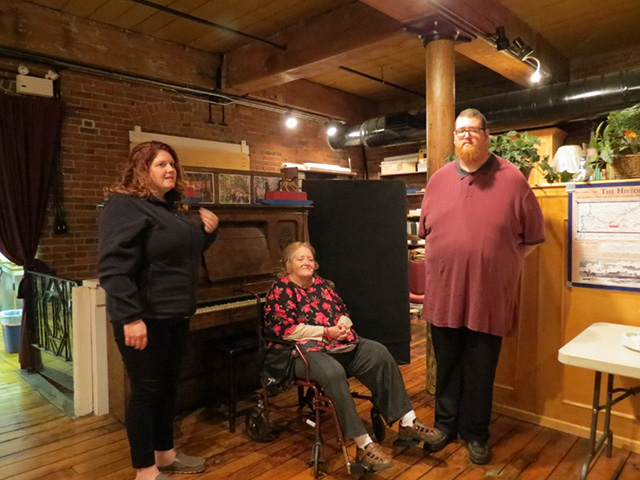
L to R Alice Nauman Jesse Preston Brandt Dan Brandt
Jesse Preston Brandt is the great-great-granddaughter of former mill owner James Robbins Faulkner. Alice and Dan’s grandfather (Jesse Brandt’s father) was James Faulkner Preston II. He was a Harvard Law graduate working in a Boston law firm when he got an offer to work for Squire, Sanders, and Dempsey, a law firm (now Squire, Patton, and Boggs) in Cleveland, Ohio and uprooted his family from Massachusetts to take the job. J. R. Faulkner II credited the aunts, who founded the kindergarten, for giving him a good start in his education.
The family’s plan was to visit the kindergarten the next day while the children were there and to tour the second floor of the building where the former bedrooms were located. Then, back in the car for a non-stop drive to Kentucky to drop off Alice and home to the Cleveland suburbs for Jesse and Dan.
DAHILL’S MIDDLESEX CANAL MURALS
INTRODUCTION
Tom Dahill painted his first fresco, a technique of mural painting involving freshly made lime plaster and executed there on with water-soluble paints, as a student at the School of the Museum of Fine Arts, Boston. It was done during the summer of 1953 while he was attending, on a special scholarship, the Skowhegan School of Painting and Sculpture in Maine. He entitled the piece, which was 12 x 12 feet, “The Temptation of Adam.” His choice of this topic reflected his growing attracting at this time to Renaissance Art and its emphasis on religious themes.
It was done on the slanting ceiling of the School’s “Painting Barn,” as former students had already used up all the wall spaces. Instructing him on the project was the noted American master of the fresco medium Henry Varnum Poor. He not only gave Dahill advice but also helped him in the actual physical process of making his first mural. That consisted in learning all the various steps that go into producing a mural.
These included preliminary drawings, creating a full-scale cartoon, the building of all needed platforms to reach the space to be used, in this case the barn’s ceiling, slaking his own lime in an outside pit, adding sand to it to make the daily plaster which he, and Poor, then applied to the ceiling. Later the involved pigments were added.
It was during his fifth and last year at the Museum School, as it was most commonly called, that he did his second huge fresco, again on a religious subject. That was entitled “The Seven Last Words on the Cross,” and was done on one the School’s “permanent walls.” Its size was 17 by 25 feet.
His purpose for doing it was to exhibit fresco technique and familiarity with ecclesiastical information as a part of his preparation for applying for the Whiten Scholarship at the School, which was for religious art. While he failed to secure that fellowship, he received instead an honor that became far more valuable to him as an emerging American artist. That was the Edwin Austin Abbey Memorial Fellowship in Mural Painting to the American Academy in Rome. The Fellowship, a Rome Prize, was renewed in 1956. It enabled him to live, study, work, at the American Academy in Rome for about two and a half years. During this period he was also able to travel extensively throughout Europe and the Middle East.
Dahill executed one other mural while at the Museum School, a decoration for a children’s playroom in a private house. He chose its subject from the rhymes of Mother Goose.
Creating murals has remained a lifelong Dahill interest, and one of his most significant murals, “Life Cycle”, can be seen and studied today at Boston’s historic First Church.
The three Dahill murals discussed in this essay grew out of his connection, and artistic work, for the Middlesex Canal Association. The first two, “The Dock” (2005) and “Middlesex Village” (2006), are part of the Association’s collection at its Middlesex Canal Museum in Billerica, Massachusetts, and the third, “The Canal That Bisected Boston” (2016), was made for permanent display at One Canal Street Apartment Homes, which was constructed on the very pathway where a canal, that was connected by the Charles River to the Middlesex Canal, once “bisected” the Boston community so that goods barged on the Middlesex Canal could be brought to the vessels docked at the wharfs that dotted the town/city’s harbor.
Tom Dahill’s interest in and work for the Middlesex Canal Association and its Museum originated in the late 1980s when he was asked to provide illustrations for The Incredible Ditch, a volume celebrating the Bicentennial story of the Middlesex Canal. That project later led to his becoming a director of the Association, and active in the creation of its Canal Museum. Indeed many of the drawings and painting used in The Incredible Ditch form the basic exhibits on display at the museum.
This essay reproduces these three Dahill Canal murals with a commentary on each one by the artist. I had thought to interview Tom and then to write up what he told me, but soon realized that “Dahill on the rocks” would be a far superior and more accurate learning experience for the reader.
For more information about Tom Dahill’s life and accomplishments consult Botega a Roma Tom Dahill at the American Academy and An American Artist Thomas Dahill, both by Alan Seaburg and published by the Anne Miniver Press.
THE DOCK (2005)
John Reardon, who with his wife Shayne, “championed” the establishment of the Middlesex Canal Museum, wanted it to have a window looking out onto the dam and the Billerica Mill Pond. He expressed this idea to me one day when we were working on setting up exhibitions at the Museum. “We need,” he said, “a view onto the waters of the Canal to give a sense of what went on.“ Fortunately there happened to be a window that might be utilized in a creative way to accomplish what he had in mind.
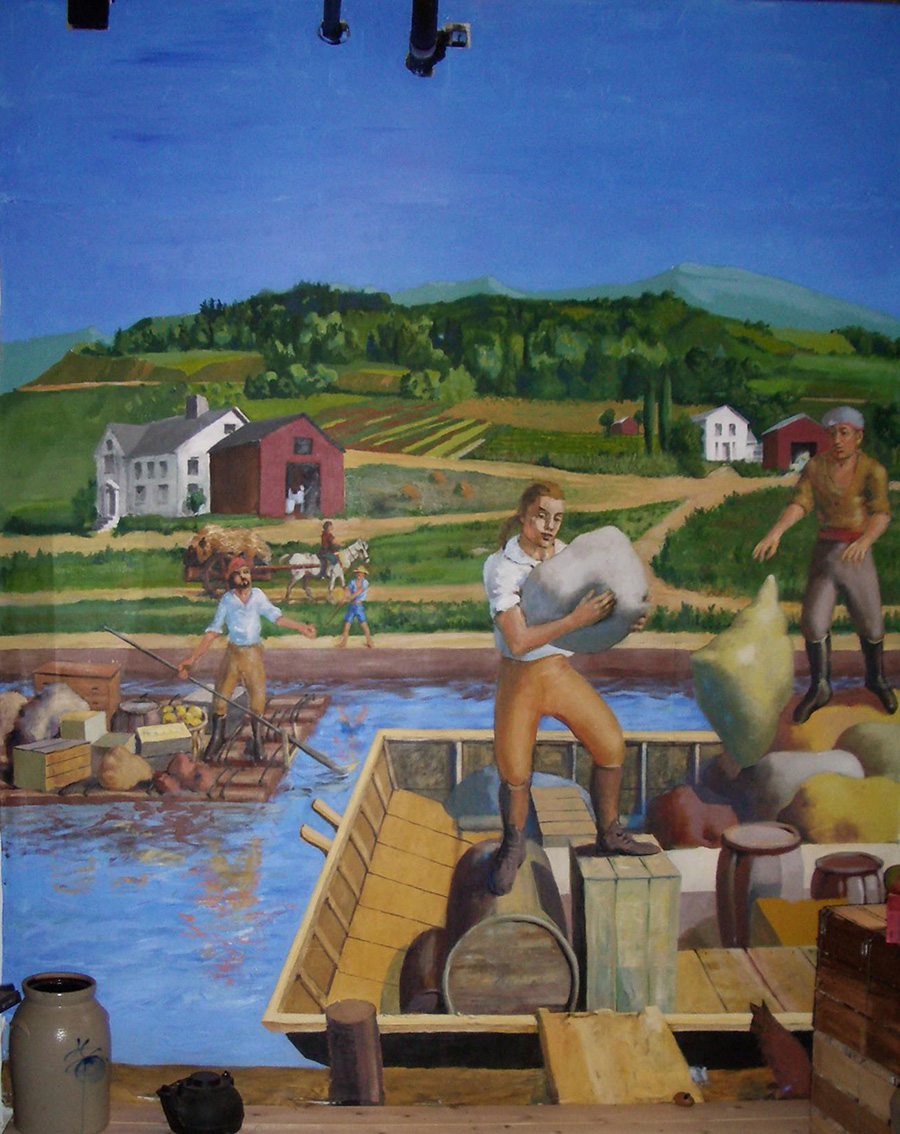
In a niche off the main gallery of the museum a partial exhibit stood in mute testimony to an incomplete idea and abandonment. So I said to John, “We could put a view of a Canal there if there weren’t so much junk in the way,” The next day John had cleared the junk out of the niche and I was committed.
The Dock” became the name for a generic scene of a barge coming up to a dock on the Canal and a New England landscape flowing behind it. I purposely identified a major figure of a young man holding a bag of cargo as the pivotal object, all others supporting the atmosphere with details relating to the time and objects of the era of the Canal. He stands a little less than life size to engage the observers. A log raft passes behind the docked barge loaded with produce and household items for sale some time later in the day, a boy fishes on the berm, beyond are two farm houses and barns, further away are rolling hills, trees, and small roads with travelers. The dirt roads and simple costumes of the figures aid in setting a time far from today with our mechanized paved roads and farms lost to housing neighborhoods. The landscape could be any New England corner, with hills flowing down to an alluvial plain with acres of pastures and planted crops, with distant rocky mountains encompassing the view.
Floor-boards of the same color as the boards of the dock and landing plank in the painting enhance an illusion that the landscape scene is a continuation of the space before it. Boxes and bags with plastic replicas of fruits and vegetables continue the effect. Most of the barge is placed to right of center but its forward corner, one which would be curved in later design for safety of the clay banks, gives a sharp feeling of space between the barge and the waters of the Canal. It serves as a transition into the landscape, and the activities, which form a backdrop for the action on the barge, thus uniting the total composition. The figure on the right, barely separate from the distance, tosses a bag toward the central action achieving an important link.
The yellow ochre of the boat and the roads serves as a unifying element throughout. In spite of the deep space and strong spatial quality of objects, the wall surface is still uncompromised. It both is a flat surface and an inviting illusion of a waterway beyond the museum.
MIDDLESEX VILLAGE (2006)
A wall with images of taverns and other building of the Canal was contemplated for a sixteen-foot length of a museum wall. The more I thought of it the more I wandered away from a collage or assembled group of images with labels. A picture is worth… and all that…became the salient stimulus for a different kind of solution.
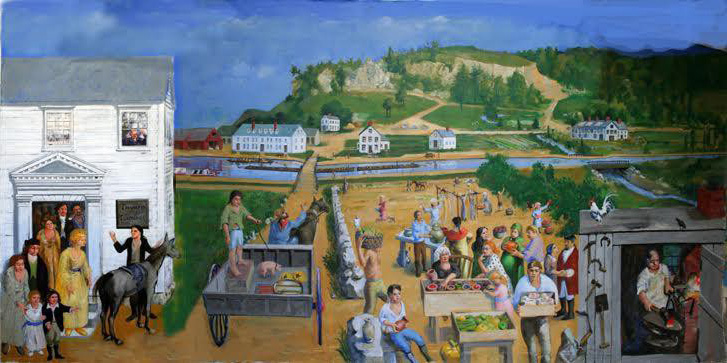
The Middlesex Village was in existence before the Canal was thought of, and occupied a position on the Merrimack River where Native Americans crossed at one time, at its angle from North to East where it flowed more quietly for its approach to the Pawtucket rapids and eventually the Atlantic Ocean.
The village was close to self-contained and had all the characteristics of any village along the Canal. There was at least one inn, barns for the horses and oxen, an open area for a market, houses of a variety of luxury, a glass manufacturing facility, and quarries not far away. Then there was the Canal with locks, bridges and an aqueduct. This village was also the beginning or end terminus of the Canal.
I ran with the idea. Early designs started out with the tavern being the important emphasis, with the view of the Canal second. Then I moved more into the landscape. Since we had a working display of a lock and models of locks, I eliminated the step lock system, which led boats and rafts from the Merrimack River to the lagoon of the village and the Canal. The aqueduct and bridges were retained which gave more information to the landscape, the glass works from a mile away was integrated into the town and the quarries of much further away, were placed in a hill within sight of the market. The foreground was filled with activities, which might have been in any town in a market filled with local crafts and produce. The tavern became a display for fine costumes of the day and also showed the men smoking clay pipes. They were an urban group who had stayed overnight and were about to return to the passenger packet boat in sight on the Canal. The young man, handling the horse, which was to be the power for the trip, ogled a young lady in a most refined dress. The people in the market area were dressed in what one might expect for townspeople involved with handling of produce. A blacksmith’s shop, which might not have been visible in this view, was tucked into the right corner. Every town and village had a forge for horseshoes to be fashioned and repaired, as well as for the manufacturing of tools and wagon accessories.
The Canal itself is the most accurate detail of the mural historically. The lagoon, which was at the height of the locks, is visible beyond the foreground tavern. Then follow several barns for livestock and another tavern all of which are accurate. The bridge, and road, which still exists today, passes over the main body of the Canal, which flows over the aqueduct and to the south. Houses on the far side of the Canal are accurate. On the Canal are three types of vessels which carried people and cargo to their ports: the log rafts, seen here in tandem with oxen pulling them, the barge or canal boat of seventy feet long, and the shorter passenger vessel, a packet boat.
My studio is large enough for an eight by 12-foot sheet of canvas on the wall. I began by working on the landscape at the top only generally putting in the market and other things in the foreground. I spent about a month on the hills, the sky, and the houses beyond the canal. The Canal was the commanding element at this time and since it stretched from one side to the other was to be the unifier; it was also where the perspective for the foreground departed from that of the upper region. Except for some details, the upper section was complete when I started on the mid and lower section.
When painting a picture for people standing at different angles to it, the total of the work should be easily understood. So to have a single point of view, a single perspective, will not work. In this work there are several perspectives at work in the foreground where in the distance there is only one.
I decided on a field of yellow ochre for the market ground, a color, which I am partial to. It is also easy to change into another color for variation of natural material. Dry dirt is a good pigment for showing dry dirt. The colors of fabrics in the costumes are also strong against the yellow field. I had fun with the subtle and minor dramas among the actors. The apple orchard was mandated by one of our board members, Betty Bigwood, who insisted the Baldwin Apples be present.
This section of the mural was installed with the help of Alan Seaburg.
I then proceeded to create the section to the left with the tavern and the visitors to the village. It took a week, using preparatory drawings coordinated with the finished part, and when it was installed for the full sixteen feet, the joint was little seen.
THE CANAL THAT BISECTED BOSTON (2016)
The reason for this mural developed from the Boston Redevelopment Authority (BRA) insistence that this area of the city required a memorial, or historical reference, to the Middlesex Canal, that showed the major historical and economical impress it had on the Town of Boston during the early decades of the nineteenth century. Therefore, when the BRA approved the apartment complex called “One Canal Street” it designated that the owners must provide such a memorial, a mandate they fully honored.
Ideas for a presentation, which would include the Boston Canal as an extension of the Middlesex Canal activity when it was invented in the design of the Bulfinch Triangle, was presented to a committee composed of the major interests for the construction of the apartment complex. It was held in the offices of Trinity Financial of Boston. After considerations, and a design to scale for a mural for the end wall of the pavilion entrance, the work, which was finally accepted, was begun.
Many sketches of activities in Boston, which were current in 1816, were made in the months preceding the final painting, and organizational designs for the presentation culminated in the agreed design. It was to be vertical. The upper area disappearing into New Hampshire would have the Middlesex Canal in strong perspective, and shrouded in a bluish atmosphere, ending in the millpond of Charlestown, which is shown in part across the Charles River.
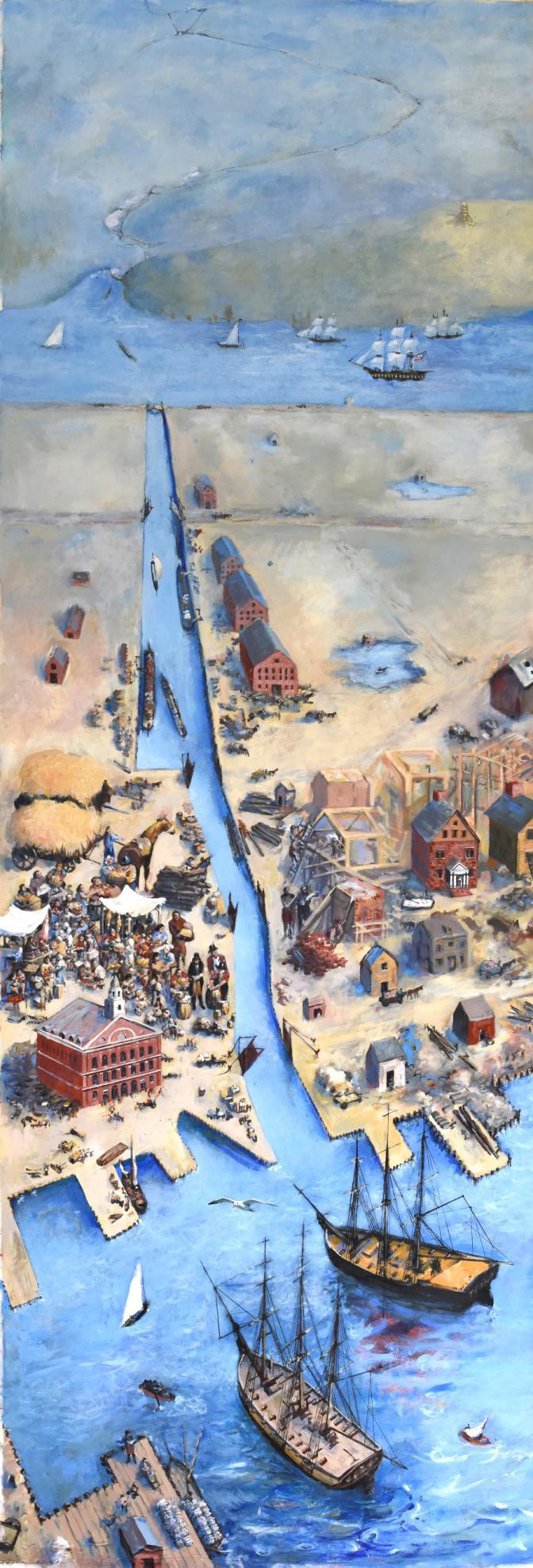
On the river can be seen several ocean going ships including the Old Ironsides Frigate, and a few small vessels including two canal boats being hauled along cables to the Boston shore. The unfinished Bunker Hill monument may be seen to the right on the hill.
The major area of the Canal deals with the activities in Boston along the Canal of the Bulfinch Triangle with its warehouses and attendant horse carriages for transport of goods for local use.
The Triangle ends at Haymarket Square with an open “farmer’s” market on the left side and with bustling architectural projects in progress on the right. The Mill Creek section of the Boston Canal divides these actions and enters Boston harbor and the Atlantic Ocean with cargo ships connecting with many parts of the world.
The Bulfinch Triangle is shown only partially filled with “clean dirt;” land being made solid in anticipation of buildings to be constructed in the future. Faneuil Hall is with the additions by Bulfinch and is on the waterfront. Quincy Market is still to be planned by the First Mayor of the City of Boston in 1822. The land on which it stands today was not as yet. Long Wharf and T Wharf have been placed in view in the lower section showing cotton being unloaded.
One of the largest volumes of cargos on the Canal was the logs of New Hampshire forests which provided fuel and building materials for housing, and were of great importance for the piles which were driven into the shallow waters of the harbor and fashioned into wharves, which were a transition to solid land. A detail of that activity is on the lower right near the building activities.
Liberties have been taken with scale and perspective. The symbolic size of the hay wagons in the mid area on the left is an example of one extreme, while the tiny men handling the draw bridges are an example of the other extreme.
The last object painted was the gull above the two ships in the harbor. It was meant to be the reference point for one’s point of view.
The mural can be viewed at two locations: the lobby area of One Canal Street in Boston and at the Middlesex Canal Museum--Visitors Center in North B.
Eagle Scout Project in Wilmington, MA
by Betty M. Bigwood
Thirteen-year-old Ian Jackson and his Dad built this kiosk on Towpath Road in Wilmington in December, 2019 to mark the access to the Middlesex Canal. It is an Eagle Scout Project. This leads to the Butters Row land given by Julia Fielding and her father Stanley Webber – the nicest walk in Wilmington.
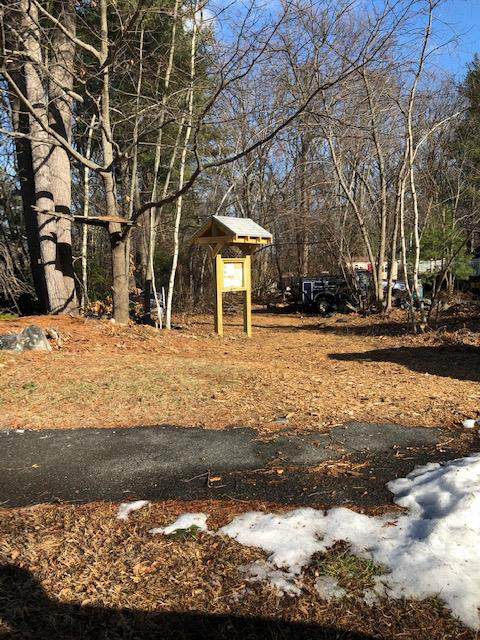
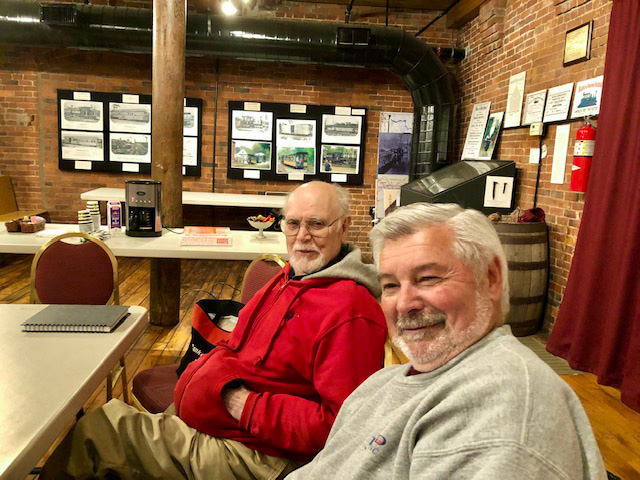
Artist Tom Dahill and our stonemason Ed Dolliver
MISCELLANY
Back Issues - More than 50 years of back issues of Towpath Topics, together with an index to the content of all issues, are also available from our website http://middlesexcanal.org/towpath. These are an excellent resource for anyone who wishes to learn more about the canal and should be particularly useful for historic researchers.
Estate Planning - To those of you who are making your final arrangements, please remember the Middlesex Canal Association. Your help is vital to our future. Thank you for considering us.
Membership and Dues – There are two categories of membership: Proprietor (voting) and Member (non-voting). Annual dues for “Proprietor” are $25 and for “Member” just $10. Additional contributions are always welcome and gratefully accepted. If interested in becoming a “Proprietor” or a “Member” of the MCA, please mail membership checks to Neil Devins, 28 Burlington Avenue, Wilmington, MA 01887.
Museum & Reardon Room Rental - The facility is available at very reasonable rates for private affairs, and for non-profit organizations to hold meetings. The conference room holds up to 60 people and includes access to a kitchen and restrooms. For details and additional information please contact the museum at 978-670-2740.
Museum Shop - Looking for that perfect gift for a Middlesex Canal aficionado? Don’t forget to check out the inventory of canal related books, maps, and other items of general interest available at the museum shop. The store is open weekends from noon to 4:00pm except during holidays.
Nameplate - Excerpt from an acrylic reproduction of a watercolor painted by Jabez Ward Barton, ca. 1825, entitled “View from William Rogers House”. Shown, looking west, may be the packet boat George Washington being towed across the Concord River from the Floating Towpath at North Billerica.
Web Site – The URL for the Middlesex Canal Association’s web site is www.middlesexcanal.org. Our webmaster, Robert Winters, keeps the site up to date. Events, articles and other information will sometimes appear there before it can get to you through Towpath Topics. Please check the site from time to time for new entries.
 Inside Old Elm - January 2020 |
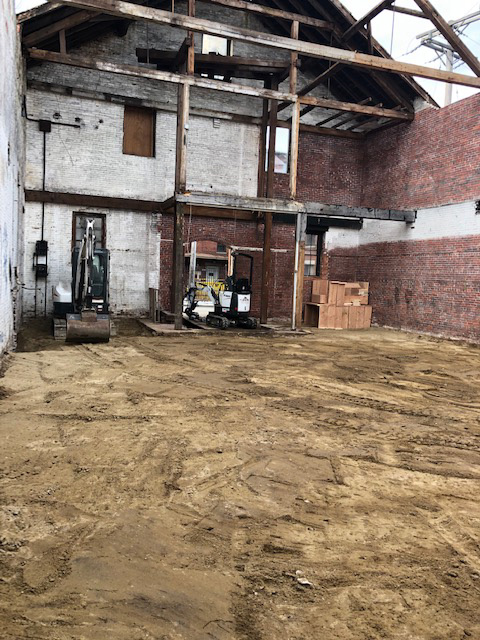 Inside Old Elm - January 2020 |
 Betty Bigwood and MCA President J Breen |
|
The first issue of the Middlesex Canal Association newsletter was published in October, 1963. Originally named “Canal News”, the first issue featured a contest to name the newsletter. A year later, the newsletter was renamed “Towpath Topics.”

Excerpt from an August 1818, drawing (artist unknown) of the steam towboat
Merrimack crossing the original (pre-1829) Medford Aqueduct,
probably on its way to service on the Merrimack River.
Towpath Topics is edited and published by Debra Fox, Alec Ingraham, and Robert Winters.
Corrections, contributions and ideas for future issues are always welcome.
Part #6 and final in the Series: A Social History of the Middlesex Canal
an e-book by Rev. Alan Seaburg
T
CHARLES AND THOMAS TALBOT
Thomas Talbot
Charles Potts Talbot was born on May 19, 1807 and Thomas Talbot on September 7, 1818 in Cambridge, New York, the sons of Charles and Phoebe White Talbot. Their parents, who were from Ireland, had immigrated to the States early in the 1800s, where their father had become successfully engaged in the manufacture of woolen goods. In 1819 the family moved from Cambridge to Danbury, Vermont where their father was again employed in a local textile mill. When he died in 1824 their mother was left to raise their eight children.
By 1825 she had moved the family to Northampton, Massachusetts where Thomas’ older brothers, John and Charles, found employment in a woolen mill, while Thomas went to public school. By 1830, at the age of 12, Thomas, out of necessity, ceased attending school and also went to work in the textile mill of John Shepard.
Five years later, Charles Potts Talbot, having established a successful woolen mill in Williamsburg, Massachusetts, hired Thomas to start working for his brother’s firm. Here he learned the many facets of the woolen trade. Financial troubles, however, forced the closure of the mill, which required Thomas to seek employment elsewhere. While doing so as a result of living frugally he was able to save sufficient funds to allow him to attend Cummington [Massachusetts] Academy from 1837 to 1839.
Upon leaving the Academy, Thomas followed his brother Charles to North Billerica. Here they opened a dyewood mill in a building leased from the Proprietors of the Middlesex Canal. In 1840 the pair formed C. P. Talbot and Company and soon outgrew the rented mill. By 1844 they had purchased a sawmill in North Billerica on the east bank of the Concord River, which they outfitted to accommodate the manufacture of dyewoods, and then expanded their business to include the manufacture of chemicals.
By 1850 the Middlesex Canal Company was nearly defunct, forced out of business by competition from the Boston and Lowell Railroad, its route paralleling that of the canal. Thus on September 22, 1851 the brothers, for the sum of $20,000, purchased the water rights, the dam and the adjacent land held by the Proprietors of the Canal Company on the Concord River in North Billerica. This investment was to prove very advantageous for them. In 1857, they completed the construction of a woolen mill at the site, and in 1860, they defended their right to maintain the dam at its present height of today against claims by the upstream meadow owners.
Within a short time, the brothers began building housing for those working in their mill. Charles eventually moved to Lowell and focused on the chemical side of the business, while Thomas remained in Billerica concentrating on the textile trade.
In 1835 Charles was married to Harriet Rogers, who had been born in Lempster, New Hampshire in 1817. It was in Lowell that they raised their three children. At her husband’s death years later she gave The Lowell Cemetery funds in his honor to replace its small wooden chapel with the present stone one.
On January 20, 1848 Thomas married Mary Howe Rogers, daughter of Calvin and Ann Faulkner Rogers, both members of prominent North Billerica families. She died on September 9, 1851. Four years later, on September 9, Thomas married Isabella W. Hayden, the daughter of the Hon. Joel Hayden of Haydenville, Massachusetts. The couple had seven children, four of whom lived to adulthood.
Thomas was a forward-thinking individual who throughout his business career demonstrated a fondness for the well-being of his employees. As the unidentified author of Thomas’s memorial expressed it, “Mr. Talbot never forgot the almost ceaseless toil required of himself and fellow mill-hands in his early days, and as a manufacturer he was an earnest, liberal and consistent friend of those he employed.” Although he was a Unitarian, he provided financial assistance, for the benefit of his workers, in the construction of the Roman Catholic and Baptist Churches in North Billerica. He also established a library in the Mill Village, funded other activities for his workers, and tried to keep the mill open during slack times.
In 1851 Thomas was elected to the State Legislature, and during the following year served on the Convention to revise the State’s Constitution. From 1864-1869, he was a member of the Executive Council. In 1872 he was elected as the State’s 29th Lieutenant Governor, and assumed the Governorship from April 29, 1874 to January 6, 1875, when the sitting Governor was appointed to the United States Senate.
During his tenure, Thomas took unpopular stances by vetoing a temperance bill and upholding the ten-Hour labor Law. Thomas received the Republican nomination for the next election, and was made the State’s 31st governor in his own right in 1878, and served in that capacity from January 2, 1879 to January 8, 1880. During this term the Prison Commission was established, the state’s budget was reduced, education reforms were made, and the state agencies were better organized and run more efficiently. Although asked to run again for governor in 1880 he declined, wishing to devote more time to his business and his family.
Despite his political and business activities, Mr. Talbot was interested in other enterprises too. He served as President and Director of the Boston and Lowell Railroad, State Director of the Boston and Albany Railroad, Trustee of the Clark Institution for Deaf Mutes in Northampton, Trustee of the Howe School in Billerica, and on his Town’s Historical Committee.
His brother Charles passed away in 1884. Thomas soon became concerned with his own health too. On Friday September 18, 1885, while walking from the Mill to his mansion on Mount Pleasant Street, the ex-governor was struck by a sudden attack of severe head pain. It was so severe that he found it difficult to reach his home, and he passed away at the age of sixty-eight at noon on Tuesday, October 6, 1885. Funeral services were held at his home on October 9th and burial was at the Lowell Cemetery on Lawrence Street in Lowell, Massachusetts.
His death was met with many memorials to his life.
Locally, in 1888, his family donated to the Town the Talbot Memorial Hall on Mount Pleasant Street, which is now gone. Six years later Talbot Avenue was laid out in his honor. The design incorporated, unique in Billerica, a small oval, which divided the Avenue’s traffic lanes. The noted landscape architect Warren H. Manning attractively arranged the plot. And in 1901 the Talbot Elementary School (now elderly housing) was erected and named as a tribute to the governor.
There exists besides the two already mentioned connections between the Talbots brothers, their mill enterprise, and the Middlesex Canal, a third major link. That is the fact that the future home of the Middlesex Canal Museum, now in rental space at the Faulkner Mills, is to be eventually located in one of the Talbots’ old mill buildings. This structure, 2 Old Elm Street, was donated to the Middlesex Canal Association by Pace Industries for use as the new home of the Middlesex Canal Museum.
Alec Ingraham
Billerica Town Historian
W
JAMES WINTHROP
James Winthrop (1752-1821) was a Director of the Middlesex Canal Company (1793--1814) and the owner of four shares of its stock.
James Winthrop was born at his parent’s “mansion” near Harvard Square on March 28, 1752. His father, John Winthrop, was the second distinguished Hollis Professor of Mathematics and Natural Philosophy at Harvard, and his great-great- grandfather was the first governor of the Massachusetts Bay Colony. His mother was Rebecca Townsend who died the year after his birth. His father then married Hannah Fairweather who helped raised the young boy, affectionately called by the family “Jemmy.”
When he was thirteen, he enrolled at Harvard. His studies included mathematics, classics, literature, and Hebrew. Later in life he was to learn many modern languages including some Russian and Chinese.
“Jemmy” proved to be a solid student, won the Hollis and Fitch scholarships, and graduated with his A.B. in 1769. His concept for his future lay in writing and college teaching, and until those goals could materialize he was content, as his entry in Sibley’s Harvard Graduates puts it, “to be a gentleman of leisure, with a bottle at hand.” Fortunately he was able to live then at home, secure in his family’s wealth, although in December he did become Harvard’s “substitute Librarian” and College Butler, positions that then required little work, which was fine with him. Later he also served for a while as the college’s Museum Keeper.
When the Revolution started in 1775 Winthrop became, that May, Cambridge’s postmaster and turned the family home into a post office, established mail routes, and hired post riders. By July, however, when he was denied a raise, he resigned.
Before then, in June, when he heard that there was to be a battle with the British at Bunker Hill, he walked with a friend to Charlestown to see if they could be helpful. There they were ordered to defend one of the rail-fence redoubts, but finding that others were already there, they joined the general line of battle. During the retreat that followed a musket ball hit his hand causing him to fall to the ground. But he quickly recovered, stood up, and when he saw that the British were not following him, returned home.
That autumn his father was appointed Judge of Probate for Middlesex County and “Jemmy” was made its Register of Probate. By good luck the courthouse was in Harvard Square, opposite the College Library, and so it was very convenient for the College Librarian to hold both positions. When his father died four years later, James, with Caleb Gannett, took over teaching many of his courses, which led James, especially when encouraged to think so by Governor John Hancock, to feel that he would be his father’s successor as Hollis Professor, but that did not happen.
In June 1771 he lost the position of College Butler when it became a full-time responsibility, but continued as Harvard’s Librarian until the Corporation eased him out in 1787 because of complaints about what he said of some others at Harvard, and of how poorly he was performing his librarian duties. The Boston Herald of Freedom reported about him, “He was respected but never beloved,” and a contemporary declared, “He was a pleasant, and generally an instructive companion. His conversation was most frequently on useful and literary topicks; and yet there was, sometimes an appearance of trifling and levity in familiar discourse, which induced a stranger to form an opinion not sufficiently favourable to his learning and his worth. We have no hesitation, however, in ranking him among the most learned, and useful and patriotick citizens of Massachusetts.”
“Jemmy” Winthrop never married. Therefore he was bound for some years by the College’s rule that unmarried faculty members had to eat and room on campus. This changed, however, when he inherited upon his father’s death in 1789, the family mansion, although he took his meals for some period after that with a neighbor who ran a boardinghouse. Eventually he hired a widow with children to live with him as his cook and housekeeper. With his living quarters now crowded, he moved his extensive book collection to a nearby building on the estate, which he set up as a “library.” It also served as a comfortable meeting place for friends and scholars to discuss important matters, such as the need for Massachusetts to have a “Historical Society.”
Although Winthrop had little fondness for the law, indeed found it “boring,” he was for most of his adult life a Justice of the Peace and Register of Probate. He was also after 1791 Judge of the Court of Common Pleas for 30 years. (His close friend Governor John Hancock had appointed him to that position.) Decades later he was removed from his Judgeship when the state decided that it was no longer appropriate for those without a law degree to be judges.
As the workload was light for both jobs, it permitted “Jemmy” much time to explore his other interests, which included the West Boston Bridge project, the Friendly Fire Society of Cambridge organization, and the building of the Middlesex Canal. But even more valuable from his point of view was all the free time these jobs and projects allowed him to devote to researching and writing his anti-federalist polemics, his Calvinistic religious essays, and historical articles on a wide range of subjects.
Many of the latter resulted from his membership in the leading historical and scientific organizations of his era. In 1781 he had been elected a member of the American Academy of Arts & Sciences, in January 1791 of the Massachusetts Historical Society, and in 1813 of the American Antiquarian Society where he was also the Keeper of its Cabinet. In addition he was a member of the New York Historical Society and of the American Philosophical Society.
Winthrop received during his life two honorary degrees: the M.A. in 1787 from Dartmouth College and the LL.D. in 1817 from Allegheny College. Later he was to bequeath his valuable library of 3150 volumes to Allegheny. After a series of strokes “Jemmy” died at age 69 on September 26, 1821.
Winthrop and the Middlesex Canal
James Winthrop, as a shareholder and close friend of James Sullivan, was actively engaged from its start with the establishment, planning, construction, and early business operations of the Middlesex Canal. This included helping to secure its charter from the state. The Independent Chronicle when printing for its readers the petition from 13 people to the Massachusetts Senate and House of representatives for “the privilege of opening a Canal from the waters of the Merrimack” to Boston listed on the petition first Sullivan’s name and second that of James Winthrop.
Once that privilege was granted, he was appointed, along with Sullivan and Christopher Gore, to the committee charged with making arrangements for the company’s first official meeting where he was elected to its Board of Directors. One of their first tasks was to decide the best route to build the Canal. So, they hired Samuel Thompson to survey the land, which he did in August 1793. Among those accompanying Thompson during the week of his survey were Baldwin and Winthrop. Later, in case errors had been made in Thompson’s survey, another committee spent a week “making observations on the level of the country” using a “device” especially constructed for this purpose. Winthrop was once again a member of this additional survey committee. It is of value in this connection to include the fact that Winthrop, in 1791, had made a survey for a possible canal across Cape Cod.
On May 12 the next year, after William Weston had been hired to do another survey, really “The Survey” of the proposed Canal, Winthrop with Baldwin, Ebenezer Hall, John Brooks, and Samuel Jaques were appointed to the committee charged with making the necessary advance preparations for this undertaking. A year later Winthrop, Baldwin, and Jaques were asked to be members of a committee to buy the tools needed for building the Canal as well as to see that a blacksmith shop was erected that could assist in making some of those necessary tools. As can easily be gathered these first years were indeed busy ones for those serving as Directors of the Canal company, requiring them to both attend regular board meetings and to serve on various special committees.
Finally the company was ready to officially “break ground” for their Canal. That took place on September 10, 1794 at the millpond and dam in North Billerica. On that occasion Loammi Baldwin dug up the first spade of earth, and James Winthrop closed the public ceremony by uttering these words, well known to those have studied the Canal’s history: “May Providence give eternal prosperity to this Canal.”
From this point forward, while he never lost his interest in the Canal, and continued to be a director until 1814, Winthrop did not play as active a role as he had previously done. Perhaps one of the most importance things he did next, however, was to write after James Sullivan’s death on December 10, 1808 a “memoir” about him for the Massachusetts Historical Society, which although it failed to mention the Middlesex Canal, or its important role in making it a positive economic force in the economic life of New England, does let us understand how Sullivan’s contemporaries viewed his character, leadership qualities, and accomplishments.
INTERLUDE FOUR: THE CANAL 1843
To celebrate the Bunker Hill dedication at Charlestown, a ten-man crew rowed a 36-foot barge, the “Bunker Hill”, up the Middlesex Canal from Medford to Lowell, passing through many sets of locks and towns on the way. They anchored the barge near the hotel, the American House, where they celebrated some more.
- Diary, Susan Brown, Epsom, N. H.
INTERLUDE FIVE: HARVARD AND THE CANAL
In 1840 Harvard University held 60 shares of stock in the Middlesex Canal, which was worth then $15,000.
- Josiah Quincy, The History of Harvard University
In 1848 Harvard University held 60 shares of stock in the Middlesex Canal, which was now worth but $2,400. This “value,“ however, the University acknowledged in its Donation Report for that year may never be realized.”
- Samuel A. Eliot, Donations to Harvard College from its Foundation to the Present Time. February, 1848.